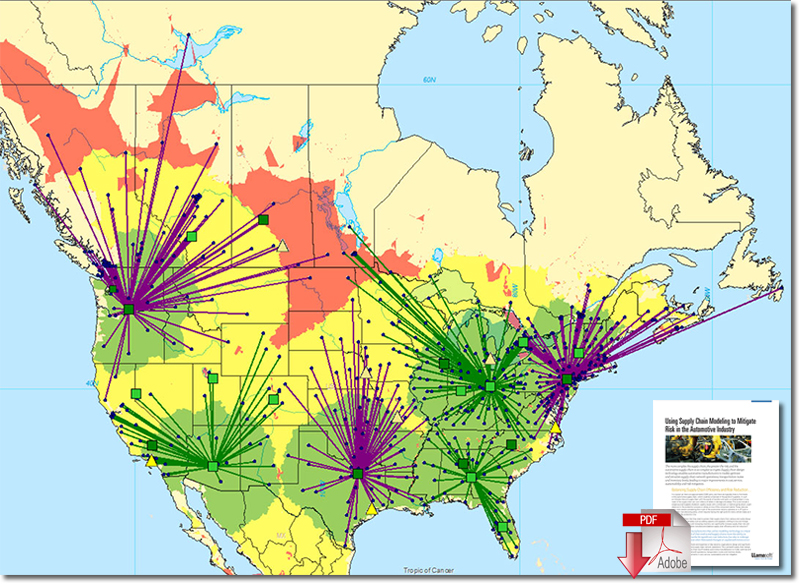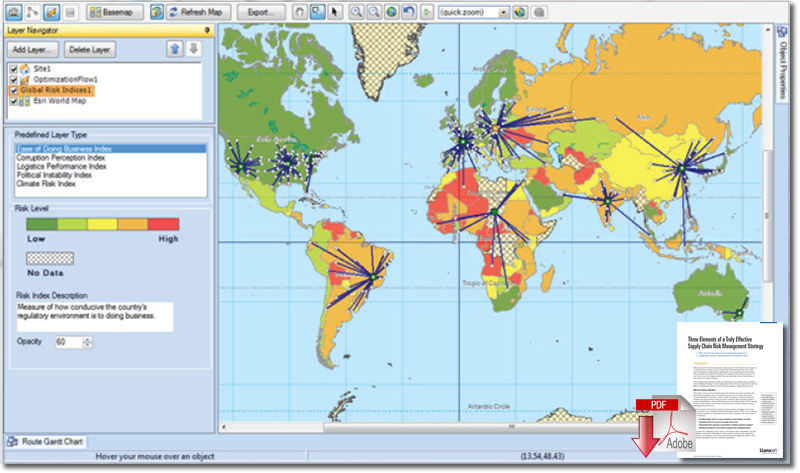Supply Chain Design for the Automotive Industry

LLamasoft® Supply Chain Guru® and LLamasoft® Transportation Guru® enable companies to model, optimize and analyze supply chain and transportation network operations, leading to major improvements in cost, service, sustainability and risk mitigation.
Use Supply Chain Design Technology to Tackle Automotive Industry Challenges
LLamasoft has enabled some of the world’s leading automotive companies to turn common industry challenges into sources of competitive advantage.
1. Inbound Logistics
Dedicating time and resources to optimize inbound logistics sometimes takes a back seat to outbound logistics efforts. Controlling the inbound transportation network and evaluating alternate network designs can reduce costs, improve service times and minimize asset usage.
Here are a few examples of how automotive manufacturers and suppliers have leveraged supply chain design technology to create efficient inbound supply chains.
- Facility selection: Sourcing decisions are some of the most vital ones automotive manufacturers face. This challenge is often referred to as the “off-shore vs. near-shore” or “low-cost vs. local” question. By using modeling technology, companies can make supplier and manufacturing location decisions that are optimized across the entire supply chain, identifying the tradeoffs across all the different cost elements.
- Transportation route optimization can be done alone or in conjunction with either supply chain optimization or simulation. Using advanced algorithms, transportation routes are defined to minimize the cost of inbound shipments, while considering realistic cost and constraint structures. This helps answer the questions, “What’s going to happen to our transportation routes when the network design is changed?” or “Could there be a more efficient way to get our product from the supplier to production?”
- Product flow-path optimization: The process of moving products from supply through production and eventually distribution presents myriad choices. The collective set of these choices make up a product’s flow-path through the supply chain. Modeling all the alternative flow options and using smart algorithms to determine the best choices takes the guesswork out of these decisions and provides a useful reference in boardroom discussions.
- Consolidation center selection and analysis: For a company with multiple suppliers making different products in a relatively small area, a consolidation center (CC) may be used to combine smaller shipments for fewer larger shipments and reduced transport costs. Flow path optimization can identify which products/suppliers should go to a CC, and network optimization can recommend where and how many CCs may be needed.
Network Optimization Map Showing Service Areas

2. Facility and Manufacturing
Demand for different automobiles shifts over time to new regions or different quantities, and suppliers and cost structures change as well. Facility locations and inventory levels should also change to keep in-sync.
- Production footprint: Modeling the production footprint and analyzing varying scenarios helps a company balance existing capacity with the investment required to add additional production. This may mean investing in additional capacity in certain locations or perhaps completely moving production capacity to other facilities within the network.
- Inventory optimization: Inventory is your insurance against variability in the supply chain, but one of the biggest sources of variability is demand, and demand can be highly unpredictable, or very slow-moving, as with service parts fulfillment. LLamasoft inventory optimization recommends end-to-end stocking levels and appropriate ordering behavior after it thoroughly analyzes and automatically classifies the underlying demand patterns. This results in right-sized inventory levels.
- Network optimization is often a starting point for companies exploring supply chain design, and can identify major improvements in cost, service and sustainability - often leading to total supply chain savings of 10 percent or more.
3. Outbound Logistics
With endless combinations of mode, routes and carriers from which to choose, automotive manufacturers are turning to supply chain and transportation network design to simplify outbound logistics decision making. Here are a few examples:
- Evaluating new modes, lanes and strategies: Using modeling technology, companies can identify optimal DC-to-customer assignments, determine the ideal mode mix and LTL/FTL combination, create optimal multi-stop delivery or pick-up routes, determine the best utilization of assets, evaluate driver work schedules and even perform service-based greenfield analysis.
- Backhaul optimization: When designing transportation networks, efficiency is the name of the game. Many manufacturers are utilizing “milk runs” or backhaul optimization in order to make the most of driver time, assets and fuel. Transportation route planning technology enables companies to design optimal multi-stop routes.
- Considering new delivery options: Should we continue to ship our own products, or consider shipping directly from foreign suppliers? For example, a domestic auto manufacturer could analyze the costs and service times of utilizing the outbound logistics network of Chinese suppliers to deliver direct instead of first shipping to the U.S.
Case Example: Service-Level Inventory Optimization
A tier-one automotive manufacturer leveraged breakthrough demand segmentation/inventory optimization technology for its service parts operation. By analyzing and automatically classifying the slow-mover demand patterns of the company’s service parts business, the inventory optimization recommended end-to-end stocking levels to better fit this irregular demand and meet target service levels at the lowest holding cost.
Mexico: Opportunity and Risk
Automotive manufacturers have plans to add considerable amounts of new production capacity in Mexico by 2016 due to rising labor rates in China and decreased lead-times of near-shoring.
But with export numbers rising, car makers are wondering whether Mexican infrastructure will be able to handle the surge. Rail will need significant fleet and track investment and ports are already crowded.
Supply chain design can help companies plan in advance to react rapidly to unplanned events in high-risk regions.
Using what-if analyses and simulation, companies can pre-plan optimal responses to events such as:
- Fluctuations in lead-times
- Supply disruptions
- Demand increases or decreases
- Fuel-cost spikes
Download: Three Elements of an Effective Supply Chain Risk Management Strategy
Supply Chain Design Strategies for Automotive Companies
LLamasoft customers often identify 10 to 20 percent cost savings while maintaining or improving customer service levels through strategic supply chain design projects including:
- Supply Chain Network Design
- Transportation Network Design
- Long-Term Capacity Planning
- Multi-Echelon Inventory Optimization
- Product Flow-Path Optimization
- Inbound Consolidation
- Greenfield Analysis
- Cost-to-Serve Optimization
- Merger and Acquisition Rationalization
- Risk Analysis and Contingency Planning
Case Example: Route Optimization
A U.S.-based automotive supplier saw considerable opportunity for improving the utilization of their fleet trucks through backhaul optimization. Empty trucks that complete deliveries early in the day can be leveraged to pick up vendor supplies or perform cross-DC transfers, which are necessary because different area DCs stock different products. Transportation route design is used in an operational workflow to form optimal backhauls given empty truck locations and potential inbound pickups. The analysis yielded millions of dollars of costs savings opportunities.
Case Example: Network Optimization and Greenfield Analysis
A tier-1 automotive manufacturer utilized supply chain design technology to model its distribution network consisting of 15 parts distribution depots in the Asia-Pacific region serving 1,800 dealers. The objective was to model and analyze the existing network to determine the optimal number and location of depots to meet defined service requirements at lowest possible cost. The analysis included multiple network optimization scenarios and greenfield analysis of potential new locations. Multiple opportunities for improvement were uncovered which would increase total depot throughput by 9.4 percent, increase the number of dealers receiving 1-day service by 28 percent, and reduce weighted average outbound distance by 14 percent.
Total Landed Cost: Bridging the Inbound - Outbound Gap
Wide gaps between the inbound and outbound sides of the business are common in large automotive production operations. This divide can lead to uninformed business decisions because of a lack of focus on the entire end-to-end supply chain, which includes the interdependencies of many cost factors including transportation, inventory and tax.
A total landed cost analysis can bring together inbound and outbound operations to quantify all supply chain activities and costs incurred to fulfill a customer’s product demand.
Only by studying this “big picture” can a business answer key questions such as, ‘Is this customer segment profitable, given the supply chain costs?’ or, ‘Does it make sense to continue to manufacture this product?’
Article Topics
LLamasoft News & Resources
Talking Supply Chain: The Truth About Digital Twins Coupa brings LLamasoft into the fold in $1.5 billion acquisition Coupa Acquires AI-Powered Supply Chain Design & Planning Leader LLamasoft for $1.5 billion Smoother execution through S&OP A Fresh Take on Supply Chain Innovation Nine Ways Food and Beverage Companies Can Use Supply Chain Design to Drive Competitive Advantage Brexit, the Next Big Disruption for the Supply Chain? More LLamasoftLatest in Supply Chain
Microsoft Unveils New AI Innovations For Warehouses Let’s Spend Five Minutes Talking About ... Malaysia Baltimore Bridge Collapse: Impact on Freight Navigating TIm Cook Says Apple Plans to Increase Investments in Vietnam Amazon Logistics’ Growth Shakes Up Shipping Industry in 2023 Spotlight Startup: Cart.com is Reimagining Logistics Walmart and Swisslog Expand Partnership with New Texas Facility More Supply Chain














